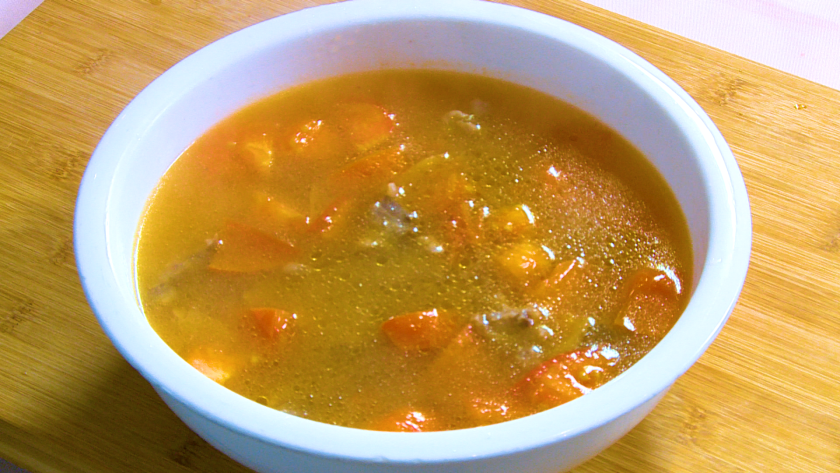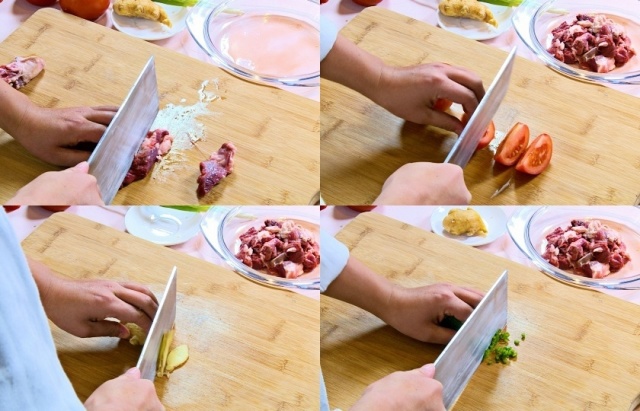Easy Tomato-Braised Beef: A hearty one-pot comfort meal


Do you want a simple and delicious dinner? This Easy Tomato Braised Beef is your answer. The tender beef is stewed until soft in the rich tomato soup. The sweet and sour taste of tomatoes and the mellow taste of beef are perfectly blended. It not only has a rich taste but also is rich in various nutrients.
Ingredients Needed and Substitutions
Main ingredients
Beef brisket: The protagonist of this dish. Beef brisket can provide rich protein for the dish. The meat is tender and juicy, and at the same time has a certain toughness. After stewing, the taste is soft and glutinous, and it can fully absorb the flavors of tomatoes and other seasonings.
Tomato: Adds a rich sweet and sour taste to the dish. Its acidity can also help soften the beef brisket and make it easier to stew until it is soft and rotten. Moreover, during the stewing process, the tomatoes will gradually melt and form a thick soup, wrapping around the beef brisket and adding flavor.
Ginger: Used to remove fishy smell and enhance fragrance.
Scallion: Used for decoration and seasoning.
Pepper: Adds a slight spiciness and unique aroma, and can also remove greasiness.
Substitutions
Beef brisket: It can be beef. According to personal taste, choose beef from different parts, such as beef shank, beef tenderloin, beef tail, etc.
Tomato: It can be replaced by tomato paste or canned tomatoes. Potatoes can also be added to increase the texture of the dish.
Ginger: When there is no ginger, ginger powder can be used instead. About 1-2 grams of ginger powder can replace every 10 grams of ginger.
Scallion: Coriander can be used instead of scallion for decoration.
Pepper: Black peppercorns can be used instead.
How Long Should Tomato Braised Beef Be Stewed?
Using a Regular Pot (Slow Cooker)
If you're using a regular pot or slow cooker, it generally takes 1 to 1.5 hours to stew the beef. During the stewing process, check the remaining amount of soup in due course to prevent it from drying up, and stir appropriately to ensure that the beef is heated evenly.
Using a Pressure Cooker
Using a pressure cooker can greatly shorten the time. First, use high heat to bring the pressure cooker to steam and then press for 10 to 15 minutes to quickly soften the internal fibers of the beef under high temperature and high pressure.
Then turn to medium heat and press for another 20 to 30 minutes. In this way, it will take a total of about 30 to 45 minutes to make the beef reach a soft and tender state.
How to Tell If the Beef is Stewed Well?
Meat appearance
Insert chopsticks or a fork into the beef or beef brisket pieces. If it can be easily inserted and the meat feels very soft without obvious resistance, this is an important sign that the meat is stewed well.
Taste experience
You can take out a small piece of meat and taste it. The taste of stewed beef should be soft and tender. With a light bite, it can spread in the mouth. There will be no situation where it is difficult to bite or the meat is hard.
If it is difficult to chew, then it may need to be stewed for a while longer.
Tips for Success
Beef brisket needs to be blanched
Beef brisket must be fully blanched. As the water temperature rises, the blood and impurities in the beef brisket will gradually seep out. After the water boils, skim off the foam and take it out and rinse it with hot water. This can effectively remove the fishy smell of beef brisket and make the soup for subsequent stewing more clear and delicious.
Tomatoes need to be cooked until juicy
During cooking, first put some tomato pieces into the pot and cook until juicy. Crush them with a spatula to release more sweet and sour taste and pectin, making the soup thicker.
Then add the remaining tomato pieces and cook for a while. This can not only retain the chunky texture of some tomatoes but also fully incorporate their flavor.
Use a pressure cooker
Using a pressure cooker can greatly shorten the stewing time and make the beef brisket soft, tender and flavorful. However, attention should be paid to reasonably controlling the pressure and time.
INGREDIENTS
Main Ingredients
-
·500g Beef brisket (about 1.1 lbs)
-
·100g Tomatoes (about 3.5 oz)
Additional Ingredients
-
·10g Ginger (about 0.35 oz)
-
·10g Green onions (about 0.35 oz)
Seasonings
-
·2g Ground black pepper (about 0.07 oz)
-
·7g Salt (about 0.25 oz)
-
·30ml Cooking oil (about 2 tablespoons)
COOKING STEP
Step 1
Ingredient processing:
Cut beef brisket into pieces and tomatoes into chunks.
Cut ginger into thin slices and green onions into chopped green onions.

Step 2
Blanching beef brisket to remove fishy smell:
Inject 300ml of clear water into the pot and heat it to 70% heat (a large amount of steam is emitted from the water). Quickly put the beef brisket pieces into the pot for blanching.
After the water boils and the blood foam and impurities fully float up, immediately scoop out the beef brisket with a colander, rinse it with hot water and drain the water.

Step 3
Stir-frying beef brisket with ginger slices until fragrant:
Pour 15 - 20ml of cooking oil into the pot and heat it evenly over medium heat. Put in ginger slices to stir-fry until fragrant.
When the surface of ginger slices turns slightly yellow, pour the beef brisket pieces into the pot and continuously stir with a spatula.
Stir-fry until the beef brisket changes color and the surface is slightly charred.

Step 4
Preliminary stewing of beef brisket:
Add 400ml of clear water to the pot, put in 3.5g of salt, stir evenly and then cover the pot.
First, use high heat to quickly boil the water. Then turn to low heat and simmer for 10 minutes to let the beef brisket initially absorb the flavor of the soup.

Step 5
Fine stewing of beef brisket in a pressure cooker:
Pour the preliminarily stewed beef brisket and soup into the pressure cooker. First, use high heat and high pressure to stew for ten minutes.
Then turn to medium heat and press for another twenty minutes.

Step 6
Adding tomatoes:
Pour the pressed beef brisket back into the pot from the pressure cooker and turn on high heat to boil the soup again.
At this time, the soup is already rich and mellow. Quickly put in tomato chunks and use the high temperature to quickly cook tomatoes until they are soft and juicy.

Step 7
Skimming off foam, seasoning and enhancing fragrance:
After the soup boils again, some foam will appear on the surface. Skim it off carefully with a spoon to ensure the clarity and purity of the soup.
Then add 3.5g of salt and 2g of pepper for seasoning.
Pour in 10 - 15ml of cooking oil again to increase the gloss and aroma of the soup.

Step 8
Finished product out of the pot:
Finally, skim off any remaining foam in the soup. After boiling on high heat, the delicious Tomato Braised Beef is completed.
Plate it and sprinkle with chopped green onions to serve.

Recipe Variations
Add carrots and potatoes.
On the basis of the original ingredients, add carrots and potatoes and cut them into chunks and stew them with beef brisket. The sweetness of carrots and the softness of potatoes add rich texture and more nutrition to the dish, making the dish more abundant.
Add mushrooms and other fungi.
Put in mushroom, pleurotus eryngii and other fungal ingredients and cut them into slices or chunks. The unique aroma and smooth texture of fungi complement beef brisket and tomatoes, enriching the taste experience and increasing the deliciousness and diversity of the dish.
Add apple or pear chunks.
The sweet and fruity aroma of fruits can neutralize the greasiness of beef brisket and at the same time add a unique flavor layer to the dish, making the soup more sweet and refreshing and enriching the texture and taste experience.
Serving Suggestions
Rice: Pour the soup over rice. Eat beef brisket and rice together. It is fragrant, soft and delicious.
Noodles: After cooking ramen noodles, mix them with tomato braised beef brisket. The soup covers the noodles and the taste is rich.
Mashed potatoes: Scoop some tomato braised beef brisket with a spoon and put it on mashed potatoes. Eat them together. It is soft.
Broccoli: Cut it into small florets and blanch it. Put it in the stew. The taste is rich and layered.
Red wine: It can relieve greasiness and echo the flavor of the dish.
More recipes worth trying
Braised Pork with Bamboo Shoots Recipe
FAQs:
Or high heat is used during cooking, causing the surface of the beef brisket to quickly heat up and become dry and tough, while the inside is not fully cooked.
For stewing beef brisket, it is recommended to first bring it to a boil over high heat, and then turn to medium-low heat and simmer slowly to ensure that the beef brisket is heated evenly and fully stewed until soft and tender.
On the other hand, stewing may start without fully frying the tomatoes to release juice, resulting in insufficient juice release.
During cooking, the tomato chunks should be fried until soft and juicy before proceeding to the next step, and the proportion of tomatoes can be appropriately increased.
It should be put into cold water. Add ginger slices, cooking wine and other ingredients to remove fishy smell. Skim off the foam after the water boils and continue to cook for a few minutes to ensure that the blood and impurities are fully removed.
If the water temperature is not high enough or the time is too short during blanching, it is difficult to effectively remove the fishy smell.
When stir-frying the beef brisket, it can be stir-fried for a while longer. After the surface of the beef brisket turns slightly yellow, proceed to the next step of cooking. And increase the amount of light soy sauce as needed to enhance the color.
Second, the timing of seasoning is wrong. If salt and other seasonings are added too late, there is not enough time for them to penetrate into the beef brisket.
It is recommended to add an appropriate amount of salt and other seasonings after the beef brisket has been stewed for a while and has begun to soften, and then continue to stew to let the beef brisket fully absorb the flavor.
During stewing, stir appropriately in time and ensure that the amount of soup is sufficient, at least covering the beef brisket.
If using a pressure cooker, pay attention to operating correctly according to the instructions to avoid the ingredients piling up at the bottom of the pot and causing sticking.

















